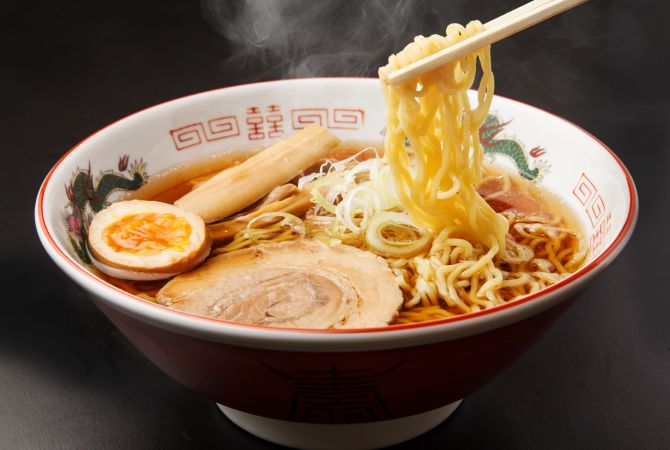Ramen noodles are the quintessential Japanese soul food
You can find ramen noodles in every corner of the country and in seemingly endless regional variations. Head north to Sapporo to try miso ramen topped with a slice of butter, or south to Kagoshima for porky tonkotsu ramen with hints of chicken and sardine stock. Japanese ramen has gone from humble Chinese immigrant food to international phenomenon, with chefs now making artisan bowls with top-quality ingredients. Ramen is one of Japan's most important comfort foods and belongs on any Japanese food bucket list.


Ramen originated in China, but has become one of Japan's best-loved foods
What is ramen?
Ramen noodles have their roots in China. How it made the jump from China to Japan is still under debate, but it's generally accepted that in 1910 a Chinese restaurant in Asakusa in Tokyo started serving a dish known as ramen. The Chinese-style wheat noodles served in a meat- or fish-based broth quickly became all the rage. Soba and udon had already cemented their position within Japanese cuisine, so while slurping up a big bowl of noodle soup was nothing new, the addition of kansui, an essential ingredient in ramen, was an innovation. Kansui, an alkaline solution, gives ramen noodles their characteristic bouncy texture. Soon, the streets of Yokohama Chinatown were filled with portable food stalls selling ramen and gyoza.
Japanese ramen continued its rise in popularity throughout World War II. In 1945, while under American occupation, Japan recorded its worst rice harvest. In response, the US provided flour as emergency aid, and school lunches began at elementary schools. Although street food stalls were temporarily banned, some of the flour was secretly diverted from commercial mills into the black market and used to make ramen. By 1950, these wheat flour exchange laws were removed just as many Japanese were returning from their posts in China, now with a taste for ramen. This confluence of events caused an explosion of ramen shops throughout the country and gave birth to countless new varieties.


Every area has its own take on this comfort food
What are the types of ramen?
Broadly speaking, there are four main ramen types. Three of the types refer to seasonings—miso ramen, shio ramen (salt) and shoyu ramen (soy sauce)—while the fourth is tonkotsu, or pork bone stock. Seasonings and stock bases, such as chicken, fish and seafood, are mixed and matched from area to area and shop to shop. Within these four main flavors, there are an endless number of regional varieties. Sapporo ramen is famous for combining a tonkotsu base with miso. Toppings include local favorites, corn and seafood. In Fukuoka , Hakata-style ramen is popular, recognizable by its cloudy pork bone broth, simple toppings and kaedama—the act of refilling your noodles while your soup is still hot.
Many smaller regions and areas across Japan also have their take on ramen. Tottori is famous for its beef bone broth, while Kasaoka ramen uses soy sauce with chicken stock topped with roasted chicken and bamboo shoots. The joy of ramen is appreciating the subtle details, from the firmness of the noodles to the angle at which the onions are sliced. Closely related dishes using ramen noodles include tsukemen, with a more concentrated soup served separately for dipping, and mazesoba, a soupless version with a strong, sauce-like seasoning. The options are endless and delicious.

Ramen is a casual dish, served and eaten quickly
How do I eat ramen in Japan?
You can find ramen shops in every neighborhood in Japan. It is casual, quick food, but some of the most popular shops can have lines out the door. Since most shops are small, it is not polite to linger over your bowl. It is best to leave shortly after finishing your meal so the next person waiting in line can sit down.
Most ramen shops will feature short menus with only a few variations on their specialty bowls and some toppings priced separately. Sides often include gyoza or fried rice, but in some cases, side dishes won't be available at all. To streamline the ordering process, many ramen restaurants do not have servers. In their place is a vending machine that has buttons corresponding to the different menu items. Simply insert money, select your ramen, toppings, sides and drinks to dispense tickets. Pass the tickets to the chef and wait a few minutes as your order is prepared.
You may notice your dining neighbors loudly slurping their noodles. Slurping is not impolite and is, in fact, the standard way to eat ramen. Don't worry if you can't do it perfectly, but try to slurp your noodles for the full Japanese ramen experience.


Instant noodles evolved out of necessity, but have become a staple
What about instant ramen?
During the post-war period, Japan was still reeling from one of its worst rice harvests in decades. America encouraged the production of bread as a cheap way to feed a hungry nation, but Momofuku Ando believed noodles would be more familiar than bread. He sought a way to produce noodles that could be easily prepared and distributed. In 1958, Momofuku Ando invented pre-cooked instant noodles with the belief that “peace will come to the world when people have enough to eat.” He founded Nissin, the company that created Cup Noodles. Instant ramen has come a long way since then, and you'll be amazed by the variety available in Japan today. Instant ramen fans will want to visit the Cupnoodles Museum in Osaka Ikeda or Yokohama to create a custom Cup Noodles and learn more about the history of this revolutionary food.
The latest information may differ, so please check the official website






























































